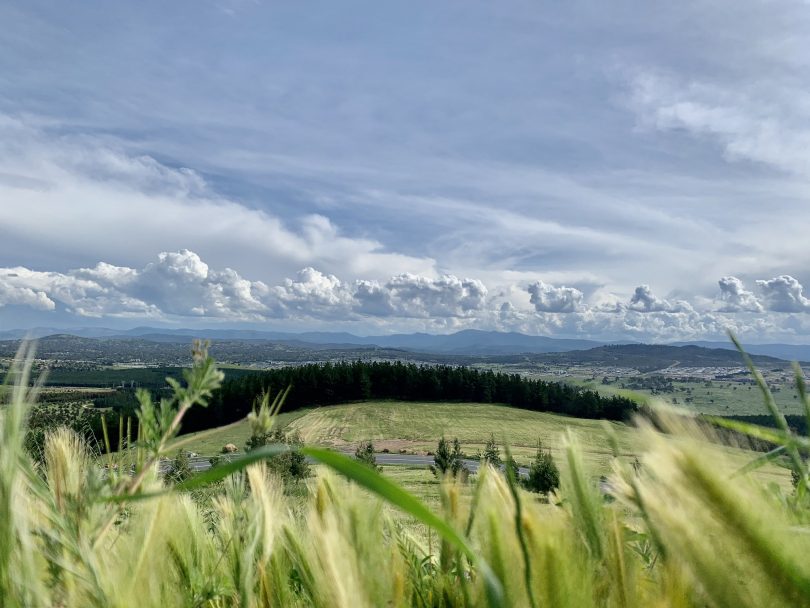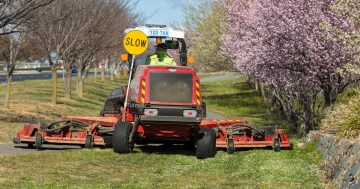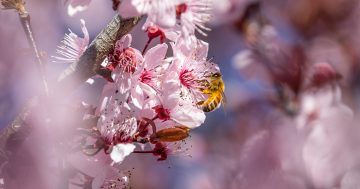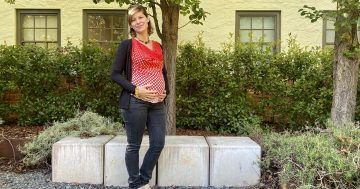
Grasses are causing Canberra’s extreme levels of pollen. Photo: Canberra Pollen Twitter.
After bushfires, smoke, hail storms and a pandemic comes ryegrass, elevating pollen counts to levels not seen in a decade, bringing runny noses, watery eyes, asthma outbreaks and that tickle on the roof of your mouth that won’t go away.
Chemists are reporting sales of antihistamines akin to the great toilet paper sellout earlier in the year.
According to Canberra’s very own pollinator and pollen counter, Professor Simon Haberle of the ANU’s School of Culture, History and Language, “this week and well into next week, we are likely to see high and extreme levels of pollen”.
“With the growth of grasses and plants, there have been record levels of pollen in the air,” he explained.
“Last Saturday (7 November) we saw pollen counts rarely seen.”
And what makes a high pollen count?
“Last Saturday, we recorded 129 grass grains per cubic metre,” Professor Haberle said.
Low levels are between 0 and 19, moderate is 20 to 49, high is 50 to 99, while extreme levels are anything above 100.
This year's rain has left a 'green footprint' on NSW, with satellite images showing significantly more living vegetation (green) than the same time last year. pic.twitter.com/Azt8EM8RIK
— Ben Domensino (@Ben_Domensino) November 9, 2020
Professor Haberle said the forecast keeps Canberra a nose in front of all contenders as the hayfever capital of Australia.
“As many as one-in-three people suffer from hayfever during the spring grass pollen season. It’s been five years since we had a big hayfever season in Canberra and we predict that this year is likely to see the return of a bumper grass pollen season,” he said.
In 2014 and 2015, the Canberra pollen monitoring team saw an average of 16 days of high pollen levels and three days of extreme levels, characterised by wet winters and above-average soil moisture.
During the drought years of 2016-2019, the grass pollen levels were much lower with an average of only three days of high grass pollen and zero days of extreme levels.
Professor Haberle said the only saving grace is the prospect of an increase in rainy days which help suppress the amount of pollen in the air.
“It’s when you get a run of clear, sunny days with north or north-westerly winds that draw pollen from the grasses to the north and west of Canberra,” he said.
“Ryegrass is the dominant grass, particularly between the months of September to December.”
And just like COVID-19, we can expect a second wave of hayfever.
“Because of climate change, we’re seeing sub-tropical grasses such as buffalo grass finding its way further south. That is usually dominant between January and February.”
While some swear by natural remedies such as a teaspoon of pure honey each morning or a tablet with garlic, horseradish and vitamin C, Professor Haberle said anyone with symptoms of hayfever should consult their GP or a chemist to discuss the best form of defence.
Asthma sufferers should also be aware of an increased risk of wheezing, breathlessness, chest tightness and a continuous cough, which are not related to hayfever but may mean you also have asthma.
Pets and animals are also susceptible to hayfever and asthma and similar symptoms apply.
Professor Haberle has developed the Canberra Pollen website and mobile phone app to help hayfever and asthma sufferers manage their symptoms on days of higher risk. You can find out more at Canberra Pollen Count and Forecast.
















